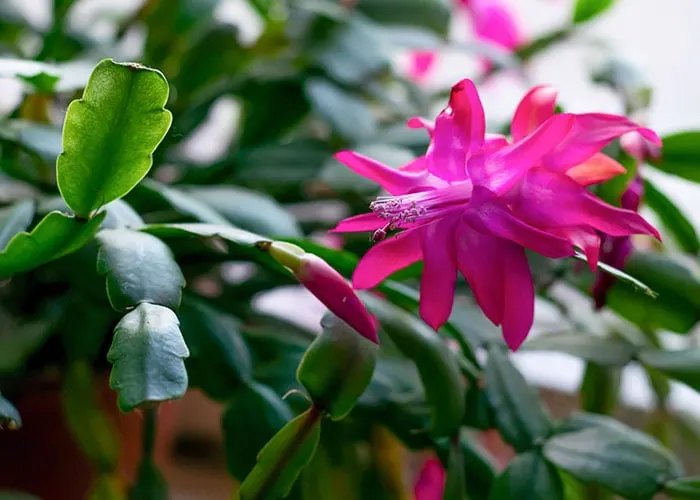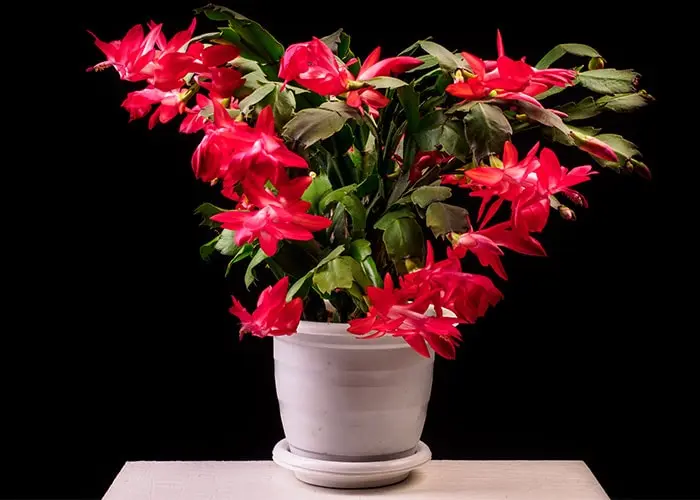This post may contain affiliate links, my full disclosure can be read here. As an Amazon Associate I earn from qualifying purchases.
How to care for Christmas cactus to have beautiful blooms at Christmas. Tips for keeping your holiday cactus healthy and thriving so you get blooms year after year.
Christmas cactus has always been one of my favorite houseplants.
Just as all the outdoor flowers have gone and the days are getting dark, Christmas cacti start to bloom and brighten up your home. They come in beautiful shades of pink, lilac, and white.
With the right care, you can grow Christmas cactus for years and even start new plants from cuttings to share with family and friends.

How To Care For A Christmas Cactus
Lighting
Christmas cactus enjoy growing with bright indirect light most of the year. If you have a north or east-facing window it will provide plenty of light for a Christmas cactus to grow.
If you need to use a south-facing window then help to protect the plant from direct light by using curtains or moving the potted plant back further from the window.
While direct light won’t harm a Christmas cactus, too much strong direct light from a south-facing window can burn the leaves.
To get your Christmas cactus to bloom you need to start reducing the amount of light it gets 6 weeks before you want it to flower.
The plant needs days with 8 to 10 hours of light and 14 hours of darkness to trigger blooming. If you have a lot of bright lights in your home at night you can help the plant by covering it gently with a sheet to block out the light.
How Often Do You Water A Christmas Cactus?

Unlike many cactus, the Christmas cactus comes from a tropical climate, not a dry dessert one so naturally, it will need more water than you would give most cactus plants.
Water your Christmas cactus when the top inch (2.54 cm) of the soil feels dry when you stick your finger in the soil.
Water the plant until water runs out the containers drainage holes and then dump out any water that isn’t absorbed after a few minutes. While this type of cactus likes moist soil, you don’t want to keep the soil too wet or you can have problems with rot.
You should always consider your local climate and time of year when watering. If you have your Christmas cactus outside during a hot, dry summer you may have to water every 2 to 3 days. Compared to if your plant is kept indoors in more humid conditions it may need water only once a week.
Cut back on watering your cactus in the early fall to help trigger it to bloom but once the flowers appear keep it consistently watered.
Humidity
Unlike most cactus Christmas cactus like humid growing conditions. For the best growing conditions try to provide 60% humidity.
The easiest way to do this if you live in a dry area is to place a tray of water near the plant as it evaporates it will add moisture to the air.
You can also add gravel to the saucer under your plants container and then fill it up halfway with water. But you need to be careful if using this method that the plant isn’t sitting in the water.
This would cause the soil to stay too moist and lead to root rot.
Temperature
During most of the year when Christmas cactus is growing it prefers a daytime temperature of 70F (21C) and night temperatures of 60 to 65F (15 to 18C).
If you have your cacti outside make sure to bring it back indoors if temperatures are going below 50F (10C).
To encourage blooming the plants need cooler temperatures. Place your cactus in an area that is between 50 and 55F (10 to 13C).
Soil
Christmas cacti will grow well in most potting soils but it’s important to provide good drainage.
Make sure that the container you use has drainage holes in the bottom to prevent root rot from overwatering.
Fertilizing
During the spring, summer, fertilize Christmas cactus every 2 weeks with a good quality organic fertilizer like liquid seaweed or fish emulsion. It’s during this time that the plant is actively growing new branches and leaves and needs the most feeding to stay healthy.
If you would rather fertilize less often try using a balanced slow-release houseplant fertilizer.
Then cut back to fertilizing once a month in the fall and winter months when the plant isn’t growing as much.
Pruning
Pruning Christmas cactus is optional but can help to encourage more branches and flowers to form.
June is the perfect time to cut off a few sections on the ends of each stem and trigger new growth to form.
If you would like to start new plants place the cut sections into a fine seed starting soil or vermiculite to root them.
When To Buy A Christmas Cactus For Holiday Blooms

When buying a new plant for Christmas blooms it’s really important to think about the time of year.
If you are buying the plant in early fall before October look for one with no visible buds or blooms. If it starts to flower too soon you’ll have fall flowers and it will have finished up before Christmas.
If you are buying in November or December then look for one that has visible buds or flowers that have just opened.
Is It Ok To Put Christmas Cactus Outside?
Yes, Christmas cactus plants can be placed outside in the summer. It’s best to keep it in a full to partially shaded area as direct sunlight can burn the leaves.
A covered porch or patio is a great place to keep them during the warm summer months. When the weather starts to turn cooler in the fall bring the plants back indoors and place it in a room out of direct light.
What’s The Difference Between A Christmas Cactus, Thanksgiving Cactus, and Easter Cactus?
There are 3 similar looking holiday cacti plants that bloom just in time for Thanksgiving, Christmas, and Easter.
Often many plants sold in stores as Christmas cactus (Schlumbergera bridgesii) are actually Thanksgiving cactus (Schlumbergera truncata) but don’t worry you care for them the same way but with slight changes in the blooming schedule.
The Easter cactus (Schlumbergera gaertneri formally called Hatiora gaertneri) is similar to the other two cacti but naturally blooms in the spring.
So how do you tell the 3 types of cactus apart from each other? You can tell by when they start to bloom naturally and the shape of their leaves.
The Christmas cactus has scalloped shaped edges on the leaf that can look like teardrops. While the Thanksgiving cactus has a more pointed and claw-like edge to the leaves.
The Easter cactus looks very different two the other two plants with is leaves having soft, rounded edges. Its flowers also have a star-shaped look that is very different from both the Thanksgiving and Christmas plants.
Another difference is their requirements for blooming. Thanksgiving and Christmas cactus need about 6 weeks of shorter daylight hours to start blooming while the Easter cactus needs 8 to 12 weeks.
Pests & Diseases
Root Rot
Root rot is a common problem with Christmas cacti and is caused by overwatering the plants too often.
If you have problems with root rot one solution is to cut out the infected parts of the roots and repot the plant into clean soil.
Blossom Drop
Christmas cactus can be sensitive to sudden changes and when the plant is stressed it will drop its flowers.
This can be caused by a change in daylight, watering, or temperature. Try to keep the growing conditions stable while the plant is blooming.
Fungus Gnats
Fungus gnats are a common problem with houseplants including Christmas cactus. The good news is, if you are careful about watering and let the soil surface dry out before watering again you might not ever have a problem with them.
If you do use these tips to get rid of fungus gnats and protect your plants.
Connect With Homestead Acres!
Be sure to follow me on social media, so you never miss a post!
Facebook | Twitter | Pinterest | Twitter
Visit my Amazon store to find all my favorite gardening, homesteading tools, and gadgets plus all of my printed garden books and journals!

Kim Mills is a homeschooling mom of 6 and lives on an urban homestead in Ontario, Canada. Blogging at Homestead Acres she enjoys sharing tips to help you save money, grow and preserve your own food.
